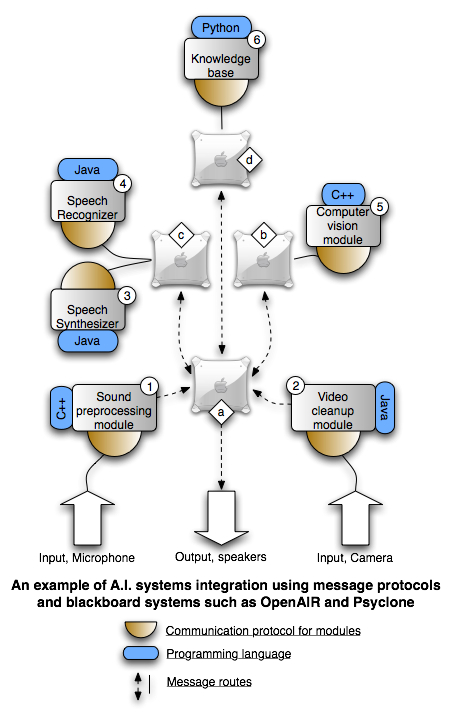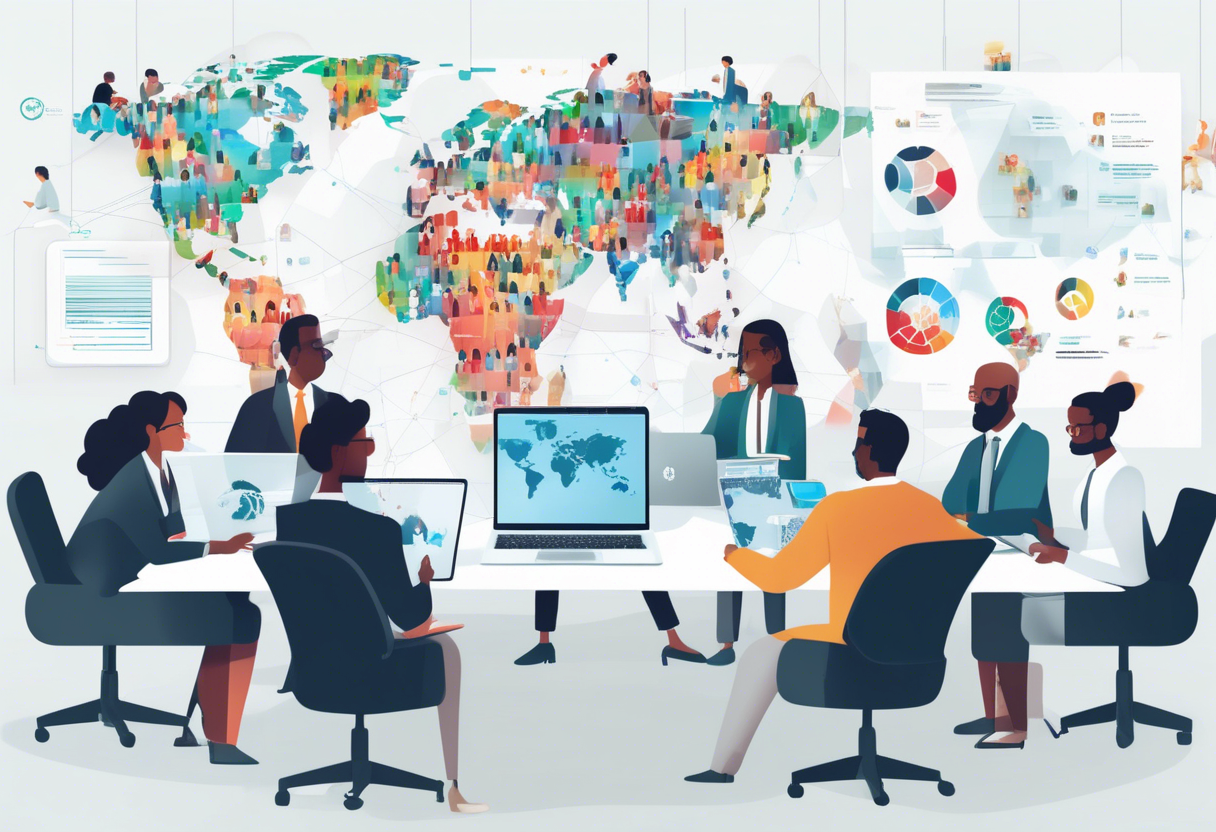
Effective communication at work isn't just nice—it's essential. Companies with strong communication strategies often perform better than those without. With AI on the rise, businesses have a chance to change how teams communicate for the better. We'll look at how AI tools can make workplace communication more efficient, engaging, and inclusive. Think real-time language translation and smart scheduling assistants. The possibilities with AI are vast. Ready to improve your team's communication? We'll guide you through using these tools step by step. Let's get started on enhancing your team's communication skills!
Step-by-Step Guide to Implementing AI Tools for Enhanced Workplace Communication
Conduct a Communication Audit and Define AI Objectives
Before diving into AI, it's crucial to evaluate your current workplace communication. Examine how information flows, the tools in use, and any potential bottlenecks. Research indicates that less than a third of internal communicators understand when and how to utilize AI, with only one in five having received any training. This highlights the necessity of a plan and audit before integrating AI.

To get a comprehensive view of your communication landscape, employ surveys, interviews, and observations. Once you have a clear understanding, set explicit goals for AI usage. These objectives should align with your broader company goals and address identified communication challenges.
Your AI strategy should have a clear purpose, such as:
- Reducing workload
- Expanding reach
- Enhancing employee engagement
For example, if your team is overwhelmed with repetitive tasks, aim to use AI to automate message drafting and improve feedback loops. Additionally, communicate the rationale and methodology behind AI implementation to your employees. This clarity can dispel confusion and foster collaboration with AI. Ensure your AI strategy aligns with your company values to guarantee strategic use.
Select the Best AI Tools for Workplace Communication
With objectives in place, choose AI tools that meet your needs. Popular choices include ChatGPT and Microsoft 365 Copilot for content creation, task automation, and message quality enhancement. When selecting tools, consider features such as:
- Sentiment analysis
- Content creation
- Automation capabilities
- Integration with existing systems

Ensure the tools are user-friendly and compatible with your current setup. Platforms like Cerkl Broadcast can customize communications to increase engagement. If you're already using Microsoft tools, Microsoft 365 Copilot might be ideal for automating planning and content creation.
Establish a Project Team and AI Implementation Plan
Form a project team comprising communication, IT, and employee experience experts to oversee AI implementation. They will ensure alignment with your goals. Develop a roadmap with timelines and responsibilities to maintain progress. Establish governance and ethics policies to guide AI use, focusing on enhancing rather than replacing tasks.
For instance, a team with communications, IT, and HR might plan a phased rollout of AI tools, provide staff training, and evaluate outcomes over 90 days.
Prepare for AI Integration (First 30 Days)
In the initial month, concentrate on integrating AI tools with your existing systems. Set key performance indicators (KPIs) such as message reach and time saved to measure success. Develop user guides and support resources to help everyone adapt to the new tools.
During this phase, IT might connect an AI content generator to the company intranet, while the communications team creates KPI dashboards and user manuals.
Pilot Testing and AI Training (Next 30 Days)
Conduct a pilot with a small group to identify technical issues and gather feedback. Provide training on AI usage, ethical considerations, and maximizing benefits. Adjust your plan based on insights gained to enhance adoption.
For example, a test group might experiment with AI-generated newsletters and offer feedback, leading to style adjustments and additional training on AI prompts.
Full AI Deployment and Continuous Evaluation (Final 30 Days)
Deploy AI tools organization-wide, monitoring KPIs to assess their impact on productivity and communication. Collect ongoing feedback to identify areas for improvement and refine AI usage. Regular evaluation helps balance automation with maintaining human communication.
Post-deployment, hold monthly reviews to analyze engagement data and feedback, adjusting AI usage as necessary.
Optimize and Personalize Workplace Communication
AI can personalize communication by tailoring content and timing to individual preferences, thereby boosting engagement. Utilize sentiment analysis to fine-tune messages to better suit your audience. Continuously refine AI-generated content to maintain relevance and authenticity.
An AI system might analyze feedback to adjust newsletters, focusing more on topics employees care about.
Assessing Workplace Communication Needs
Identify current communication challenges, such as dispersed teams or low engagement, to effectively target AI integration. Understanding your workforce's unique traits, like remote workers, aids in selecting the right tools.
For example, with many remote employees, you might need AI tools that automate and personalize mobile communications.
Setting Clear AI Objectives for Workplace Communication
Establish clear objectives to address specific issues, such as reducing turnover or improving message consistency. These should align with business goals and be clearly communicated to gain everyone’s support.
For example, aim to reduce the time spent drafting communications by 50% in six months using AI tools.
Selecting Effective AI Tools for Workplace Integration
Evaluate AI tools based on features, ease of integration, and alignment with your needs and culture. Look for tools that automate routine tasks, personalize content, and offer analytics. Pilot testing with user groups helps assess suitability before full rollout.
Experiment with several AI platforms to determine which integrates best with your workflows.
Training Teams for AI-Driven Communication
Develop training programs covering AI tool functionality, ethical use, and effective prompting. Encourage continuous learning to keep pace with AI advancements. Include practical sessions to build confidence and competence.
Workshops might feature live demos of AI content creation and scenario-based exercises.
Measuring AI Impact on Workplace Communication
Define KPIs such as engagement rates and time saved to evaluate AI's impact. Continuously analyze feedback and usage data to improve AI deployment. Utilize AI tools for sentiment analysis to measure effectiveness in real-time.
Monthly reports could track reductions in drafting time and improvements in engagement scores following AI implementation.
AI in workplace communication employs technologies like natural language processing and chatbots to automate tasks, provide real-time assistance, translate materials, and analyze feedback. This enhances efficiency, reduces workload, and supports decision-making. Effective AI use balances automation with human communication to improve collaboration and productivity.
Companies like Slack and Microsoft Teams leverage AI tools like chatbots to boost productivity. Microsoft uses AI for collaboration and task automation, while Slack employs chatbots for FAQs and scheduling. Otter.ai provides real-time transcription to enhance meeting productivity. Salesforce Einstein personalizes customer interactions, improving communication.
A Gartner study reveals that organizations with comprehensive AI training have a 25% higher adoption rate. Additionally, 46% of businesses use AI in communications, underscoring its growing significance. Salesforce reports that 75% of employers aim to automate tasks with AI, highlighting its importance in communication.
A 30-60-90 day plan for AI tools involves:
- First 30 days: Preparation with a communication audit, tool selection, KPI definition, and team formation.
- Next 30 days: Pilot testing, training, support resource creation, and plan adjustments.
- Final 30 days: Full deployment, KPI monitoring, feedback collection, and refinement.
A phased approach with small-scale pilots and gradual scaling is optimal for adoption.
Best practices include:
- Conducting a communication audit
- Selecting AI tools that integrate well
- Establishing a cross-functional project team
- Developing training programs
- Piloting tools with small groups
- Defining KPIs
- Continuously refining AI usage based on feedback and performance data
FAQs
How Can AI Tools Enhance Real-Time Translation in Workplace Communication?
Enhancing Multilingual Collaboration
AI translation tools are revolutionizing workplace communication by breaking down language barriers. These tools facilitate seamless collaboration among diverse teams by quickly translating spoken or written words. This capability is particularly useful for meetings, emails, and chats. When employees can communicate in their preferred language, it enhances idea sharing and boosts productivity.
Imagine an international team on a video call using AI to translate speech in real-time. This allows everyone to contribute, regardless of their native language. These tools integrate seamlessly into platforms like video conferencing, chat apps, and email, enabling global teams to collaborate without waiting for human translators.

What Are the Main Challenges of Integrating AI into Workplace Communication Systems?
Overcoming Compatibility Issues
Integrating AI into existing workplace systems can pose challenges, such as software compatibility issues and data privacy concerns. Many organizations rely on legacy systems that may not readily support AI technologies. To address this, businesses need a comprehensive plan to ensure that AI tools function effectively within their current infrastructure. This may involve selecting appropriate APIs and middleware for a seamless integration.
Additionally, it's crucial to manage the frequency and timing of AI-driven messages to prevent employees from feeling overwhelmed and to maintain the relevance of communications. For instance, when a company introduces an AI translation plugin to their messaging app, the IT team must address compatibility issues and ensure smooth data flow without disrupting existing workflows.
How Does AI Personalize Workplace Communication for Different Employee Segments?
Tailoring Messages to Individual Needs
AI enhances workplace communication by personalizing messages for various employee segments. By analyzing communication preferences and habits, AI can customize messages to meet individual needs, making them more engaging and easier to understand. This personalization may involve adjusting the style, channel, or timing of messages based on roles, locations, and personal preferences.
For example, AI might determine that remote workers prefer concise email updates in the morning, while on-site employees favor quick video summaries during team meetings. By delivering personalized content, AI ensures that messages are clear, relevant, and resonate with different employee groups, fostering a more inclusive and efficient communication environment. This approach enhances understanding and encourages action, ultimately boosting workplace communication and productivity.

Effective workplace communication not only boosts employee engagement and retention but also improves interpersonal skills and emotional intelligence, leading to better collaboration and productivity.